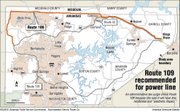A Missouri senator filed a bill Thursday to try to stop Southwestern Electric Power Co. from building a high-voltage transmission line through rural Barry and McDonald counties.
Sen. David Sater, R-Cassville, filed Senate Bill 839 in an attempt to prevent a 345-kilovolt power line from being constructed in the part of Missouri he serves. The proposed 56-mile line, which would begin and end in Arkansas, would enter southwestern Missouri for 25 miles along its route from Centerton to Berryville.
“It’s within a mile of the state line,” said Sater. “I don’t know why they didn’t move it a mile south of the line. It’s a straight line through there. It’s the same type of property. It just doesn’t smell good to me. They could put it 2 feet south of the line, and we wouldn’t have anything to say about it.”
A similar bill was filed in the Missouri House of Representatives on Jan. 28 by Reps. Scott Fitzpatrick, R-Shell Knob, and Bill Lant, R-Pineville. It is House Bill 1622 and was referred to the utilities committee on Wednesday.
Both bills are in response to the Jan. 17 decision by Connie Griffin, an administrative law judge with the Arkansas Public Service Commission, approving Route 109 for the transmission line. Initially, six routes were proposed, but after months of consideration, Griffin said Route 109 is the only one that’s “reasonable” based on residential and aesthetic impact.
SWEPCO had preferred a shorter, 49-mile route that would have cost the company $6.5 million less to construct.
With authority only in Arkansas, Griffin approved only the 31-mile portion of Route 109 in Arkansas. SWEPCO must file with the Missouri Public Service Commission for approval of the 25 miles of the route in that state.
Sater said he had vowed to fight Route 109 if it was approved in Arkansas, but he didn’t think it would be because of the extra regulatory hurdles that construction in Missouri would require.
“This bill is keeping that promise to my constituents,” said Sater. “It protects their property rights and sends a clear message to SWEPCO and the Arkansas [Public Service Commission] that they need to address an Arkansas problem in Arkansas. … I don’t see any reason for that line to come into Missouri.”
Peter Main, a spokesman for SWEPCO, said the company will “work to address the concern of Missouri legislators, regulators, landowners and other stakeholders as we seek to complete the project.”
Main said Route 109 was provided as “the only feasible northern alternate route.”
“Southern Missouri was included in the project study area because of extensive development along the Interstate 540 corridor in Northwest Arkansas,” he said. “To avoid the heavily developed commercial and residential Bella Vista area, which extends to the state line, the route crosses into Missouri.”
SWEPCO must also file with the Missouri Public Service Commission to become a public utility in Missouri, but it can do that with its application to build the power line. SWEPCO serves more than 200 communities in Louisiana, Texas and western Arkansas but none in Missouri, according to the company’s website.
Some legislators in Missouri’s southwest corner don’t want the power line in their back yard.
To support the line, six 130- to 160-foot-high towers would be needed every mile, according to SWEPCO’s proposal. A 150-foot-wide right of way also would be required along the route. In Arkansas, opponents declared the towers too unsightly and worried that they would hurt the area’s tourism industry.
Sater said he believes his bill has “more teeth” than the one filed in the House.
The House bill would give jurisdiction over approval of the power line to the Legislature instead of the Missouri Public Service Commission.
Sater’s bill would prohibit SWEPCO from using eminent domain to take land needed for construction of the transmission line. Instead, the company would have to get the approval of every landowner along the route, Sater said. Those landowners could refuse to sell their land, and the Arkansas Public Service Commission and SWEPCO would be forced to look for an alternate route, he said.
Pat Costner, director of Save the Ozarks, which opposes the transmission line, praised Sater for filing the bill.
“It simply and precisely takes away SWEPCO’s power of eminent domain in those counties in the path of SWEPCO’s Route 109,” she said. “This means that SWEPCO will be forced to reach a mutually beneficial agreement with each individual landowner whose property is in their path.”
No public hearings have been held on the proposed power line in Missouri, said Sater.
Missouri was mentioned many times in the filings before the Arkansas Public Service Commission pertaining to the transmission line.
According to SWEPCO’s initial filing on April 3, “These proposed facilities are intended to meet the additional transmission capacity of the growing north Arkansas and south Missouri area.”
The “proposed facilities” were identified in the Southwest Power Pool’s transmission expansion plan (2008-2017), according to the filing. SWEPCO is required to build transmission projects within its service area if the Southwest Power Pool determines they are necessary, David Matthews, the company’s attorney, has said.
Arkansas, Pages 10 on 02/08/2014
